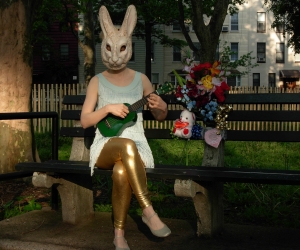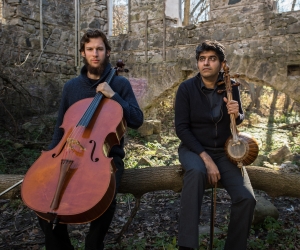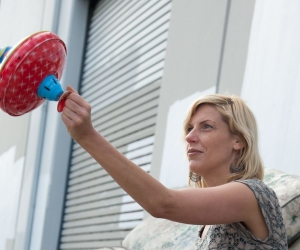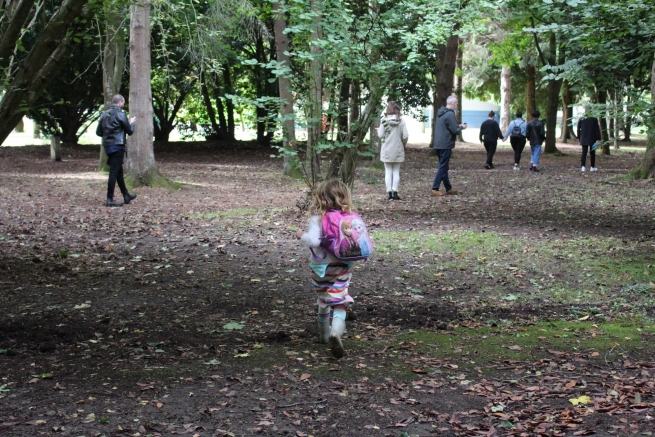
We tend to think of an emergency as something sudden—the kind of jarring, life-and-death situation that leaps out at us with abrupt urgency. And when we think about what an emergency sounds like, that assumption is often fresh in our minds: sirens, clatter—noises sharp and loud that aggressively hold our attention.
But what happens when a crisis becomes more and more protracted, and remains with us indefinitely? What happens when the emergency is planetary?
Lately, the circumstances of our listening have felt increasingly urgent. Extractive human systems have given rise to ecological crises on a global scale, causing extinctions, endangering land, amplifying inequities, and changing the temperature and quality of the air. Social and environmentalist movements have often looked to sound as a marker of these crises. Rachel Carson’s influential 1962 anti-pesticide book Silent Spring, which imagined a future without birdsong, famously sparked a global movement of environmental activism. More recently, Japanese music researcher Noriko Manabe traced how musicians and songwriters carried the weight of anti-nuclear protests following the Fukushima Daiichi nuclear accident of 2011.
Artist Raven Chacon has been moving between multiple projects that similarly focus on listening as a form of sense-making, where sound and language become pathways for reflecting on and analyzing challenging circumstances. In the same way, artist Lou Sheppard, whose practice is often rooted in environmental issues, has been investigating sound as a means of interpreting crisis and loss, and has been questioning whether the processes embedded in music-making might lead to new forms of ecological understanding.
Sometimes emergencies appear and disappear in an instant; sometimes they stretch over months and years. No less varied are the sounds that emerge—and the listening that they demand.
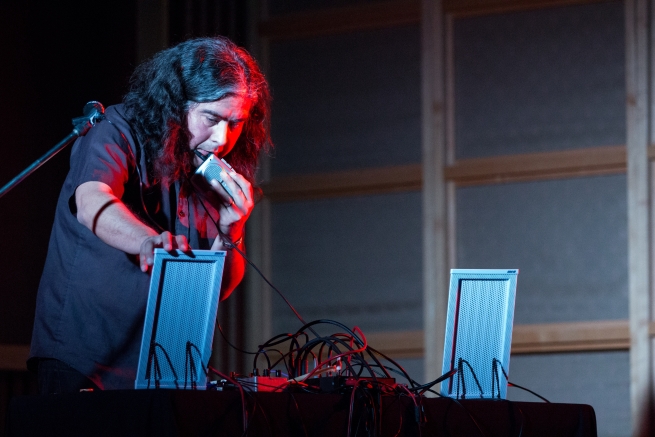
Raven Chacon, who is from Fort Defiance, Navajo Nation, received his music MFA in 2004 from the California Institute of the Arts School of Music, where he studied with James Tenney, Morton Subotnick, Michael Pisaro, and Wadada Leo Smith. His practice, which bridges noise music and works composed for classical instruments, draws on both graphic- and text-based notation and includes composition, performance, sound art, and installation. He’s created work as a solo artist, as a member of the Indigenous arts collective Postcommodity (from 2009 to 2018), and more recently, as one half of Endlings, his guitar and electronics duo with guitarist John Dieterich (of experimental rock band Deerhoof).
Field Recordings—a 1999 installation comprising headphones, audio, photographs, and text—was the first work Chacon ever made, as he tells me during a video call from his home in Albuquerque, New Mexico. “I had become aware of field recordings, and of this idea that a lot of Indigenous folks and people all over the world had at the advent of photography, that something is being captured of you [when your photo is taken], that there is some kind of trading involved. There still is. If somebody wants to take your photo, they’re trying to place it in some kind of context. I was thinking about that in sound, and at the same time, I was interested in the limits of that technology.”
For Field Recordings, Chacon visited and recorded three particularly quiet places in the Southwest and then turned the volume of the recordings up to their maximum. “I went to places that require quiet and tried to see what could be heard,” he says. “But when I had done that, I still felt like I was the anthropologist, or the person trying to recontextualize the ‘nature’ [gesturing quotation marks] that I was listening to. That’s why I decided that the land should have every opportunity, even at the limitations of technology, to speak as loud as it wanted to.” On “Window Rock, 4:00am,” the first of the three recordings, sounds of birds and wind are distorted with electronic artifacts, becoming loud and confrontational, as if pressed directly against the ears. The noise is gritty and relentless.
Loss and conflict and their relationship to place have been recurring themes in Chacon’s work. To perform Report (2001), an ensemble assembles outdoors and uses various-calibre firearms as musical instruments, following a score for firing them. On We Lost Half the Forest and the Rest Will Burn This Summer—Postcommodity’s 2015 concept album of sixteen songs written by Chacon, Nathan Young, Kade Twist, and Cristobal Martinez—the decay cycle of a desert drought is told from the perspective of its flora and fauna, with performers using voice and both Western classical instruments and Postcommodity’s own Southwestern-rasquache electronics. On “Another Black Sky,” the album’s fourth track, string instruments cycle through drawn-out, sighing gestures. The next track, “Estos Arroyos,” shifts between erratic noise and abrupt quiet, the electronics sizzling with a haunting, ominous quality.
Dispatch, a conceptual score, brings into sharp relief the urgent feeling hovering in the background of those earlier works. Cocreated with curator and writer Candice Hopkins, a citizen of the Carcross/Tagish First Nation, Dispatch was published in 2020 as part of Unsettling Scores, a series curated by Liquid Architecture (an organization for artists working with sound and listening) for the Monash University Museum of Art in Melbourne, Australia. The Unsettling Scores website notes that Dispatch “draws from Chacon and Hopkins’ reflections on the fight for cultural preservation and defence of Indigenous sovereignty at the Standing Rock Reservation Water Protector encampment in 2016.”
“Dispatch is probably the most ecological piece I’ve worked on,” says Chacon. “My work is often about the land, and histories of the land—but I think that this piece is specific about crisis.” Presented in three parts—or dispatches—the score is framed as both a transcription of the events around the 2016 Dakota Access Pipeline encroachment at Standing Rock and a prompt for speculation about, and action in, the future. As with many conceptual scores, it lists the possible players involved—Hosts, Spiritual Leaders, Frontline Activists, Helpers, and Witnesses, among others—and provides words and schematics that serve as instructions. The possibilities for enacting the score are intentionally vague: it can be understood as a record to be read, as a guide for performance, or as a prompt for direct action.
Chacon explains that for him and Hopkins, building in these different layers was a core part of the creation process. “It was important for us to say that this artwork is not a solution: it’s more of a proposition to analyze, and to imagine various scenarios. It’s trying to consider these scenarios with the tools and knowledge that we have as musicians and artists.”
As part of the process of cocreating the score, Chacon referred to recordings he’d made during his visits to Standing Rock in 2016. It became another moment to interrogate the ethics of recording, and to question the idea of listening as a peaceful or meditative act. “There’s quite a privilege in being able to go out into so-called nature, and just sit and listen and relax,” he says. “That’s not always the case: quite often we’re in a situation where we’re having to defend the land, and where we’re up against very violent conditions. How can you do deep listening in that situation? We’re hoping that a product of realizing this score will be not deep listening, but maybe a focused listening. Or a targeted listening. That’s what this score was thinking about.”
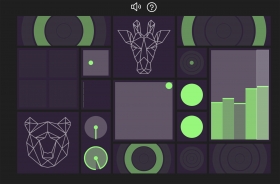
Parallel 03, another recent work, explores in a different way the issues of difficulty and chaos in listening conditions. The collaborative project brought together Endlings (Chacon and Dieterich) and six Vancouver music and sound artists—Parmela Attariwala, Adrian Avendaño, John Brennan, Elise Ferrari, Marina Hasselberg, and Alanna Ho—to compose, improvise, record, and arrange each other’s ideas, each artist anonymously contributing to a shared online repository. Parallel 03 was first presented by Vancouver New Music in November 2020 and now exists as an interactive website installation—a generative blend of sounds, images, videos, drawings, and texts that allows the user to control parts of the materials and the mix.
I tell Chacon about a voice I heard through the jumble of the texture when I first accessed the website, and the disorienting feeling of being unable to tell who it belonged to. He says that when he was shuffling through the folders of anonymously submitted material, he had a similar experience of listening and failing to understand. “I think that [feeling] was something that came about naturally, given that we’re all in some kind of isolation right now,” he says, referring to the ongoing COVID-19 pandemic. “The original plan was that we were supposed to make a project [together] in person, in the same room. And that couldn’t happen. So instead of trying to fight against that separation, we tried to eliminate the context—start on a blank slate, and then see what emerged.
“I’m interested in this idea of reminding ourselves of ourselves, and where we fit in in this world,” he adds. “Maybe as musicians, we might have the abilities to decipher it, to filter and analyze those dissonances.”
When I revisit the Parallel 03 website a few days later, it loads a collage of fluttering strings, overlaid with soft distortion and static. I can’t hear the voice at all, and I wonder if I had only imagined it.
Lou Sheppard has always thought about ecological circumstances as part of his interdisciplinary practice. His work, which frequently incorporates audio, performance, or site-specific installation, often engages with issues of climate disruption and environmental loss—the kinds of slow, ecological traumas that are so huge as to be paralyzing, but in other ways can be almost imperceptible.
The first thing Sheppard and I talk about during a video call from his home on the south coast of Nova Scotia/unceded Mi'Kmaq territory is how he has been creating musical scores as a vehicle for understanding the nature of places. “The way that I’ve thought about [scores] has really shifted over the past couple of years,” Sheppard says. “At first, I thought of a score as something that someone can perform, as a piece that someone can then take and reenact. And now I’ve started thinking about a score as more of a bridge between something that’s happened, and something that could happen—this potent document that holds that past and future in it.”
Sheppard, who has a theatre-and-visual-arts background, was drawn to graphic scores and text-based notation as an entry point to sound. “I understood Western music notation a little bit, but this idea of a fixed notation felt untrue to what I was trying to do,” he explains. “I didn’t want things that were descriptive. I wanted things that were more gestural.”
Spectrograms—visual representations of the frequency spectra in audio signals—often appear in Sheppard’s scores. For his 2019 installation Dawn Chorus / Evensong at the Toronto Biennial of Art, the singing patterns of birds at dawn and dusk on Lake Ontario were traced and layered onto a musical staff to create notation for an eight-channel, fourteen-hour audio installation in the Toronto Sculpture Garden. Nine Songs for New York, another work from 2019, uses spectrograms of endangered birds in New York state, abstracted and arranged into geometric shapes for interpretation by a vocal ensemble. The New York scores are sparse, lightly traced greyscale, akin to print or pattern-making. On one, a gridlike image is fragmented and stamped onto the page; on another, a faint cloud of dots is barely visible on the white page.
“I started thinking about this idea of the languages that we’re given to access our environment,” Sheppard says. “The language of spectrograms became really interesting to me, because they are a kind of empirical representation: this is a scientific proposition, and this is how this scientific proposition creates this bird song, how it listens to it. I guess I was thinking about what happens when we start to trouble that idea of data collection. If what we are given to face climate crisis is a lot of data and a lot of numbers and a lot of facts, then how can we shift that language towards something that we can be present in and [thus] maybe shift our understanding?”
In 2020, during a year-long residency at Branscombe House in Richmond, British Columbia, Sheppard developed a series of community-engaged, site-specific works on the effects of urban development and climate change in the area. One of those works, Rights of Passage, focused on the ghosts of rivers in the city that had been dammed, paved over, moved, or dried up. Sheppard created a map of walking trails for moving through Richmond along the paths of four missing riverways. “The idea was that you could move through the city, and as your body was moving, you were re-performing this movement of the river. And as you listen to the sounds of the city, with rushing cars, noises that still are in the environment, natural sounds, this sort of babble of humans . . . you can start to hear what a river might have sounded like.”
Sheppard took field recordings from the walking path and processed them into an audio file that enhanced the sounds’ river-like qualities, making the file available for participants. Since then, however, Sheppard has moved away from composing audio for the walks, trying instead to reach towards the inaudible. “I’m working on a new project now that’s about a lost waterway, and I’m just asking people, ‘If you pause here, can you still hear this water?’ Something that I’ve really been thinking about a lot is how something that our bodies do might echo or connect to another gesture that’s happening . . . I often think, If we can recreate some of these gestures that might have happened, does that call them back? Or is that a way of remembering?”
In his 2018 work A Strong Desire, this notion of a gesture of absence was brought into a dance and visual performance piece. The work grew from his reading of how the fifth edition of the Diagnostic and Statistical Manual of Mental Disorders (DSM-5) defines the diagnostic criteria for gender dysphoria, a diagnosis that often stands as a barrier to trans access to health care. Sheppard looked through the DSM-5 text at the spaces between words, searching for ways to interpret the negative space on the page into notation for a performance score. “I was aware of this diagnostic text, and I was aware of how inadequate that text was at describing what my experience of the world was, and what my experience of my own identity was. I was thinking of that as a bad translation—an impossible translation.”
He began exploring the idea of the lacuna, the gap between a word in one language and its closest possible translation in another. “The word ‘lacuna’ has a Latin origin in the word lake,” Sheppard tells me. “You can almost imagine an expanse of water that fills in the gap between these two attempts or two moments. I was imagining that lacuna as a kind of queer space. I notated the spaces in between each word, and then widened and performed those negative spaces through gesture.”
In a follow-up project at Vancouver’s Audain Gallery—presented at a 2019 exhibition where Raven Chacon’s works were also shown—Sheppard took twelve poses from his score to create kinespheric drawings, reaching out with inked hands and feet to trace his movements along the gallery wall. The resulting image is not unlike his musical scores—streaks of greys on white, through which a viewer can almost follow the path of a pirouetting body or of outstretched hands, the traces of a feeling translated many times over.
“That project really got me thinking about this idea of loss in the environment, loss in the climate—of how we attend to loss, and what it means to try to look at what happens when something is missing. How do you gesture to something that isn’t there?
“You can’t really describe something that’s lost,” he adds after a pause. “But I can find strategies to point to it, to say, ‘Look in this direction, where this lake exists.’”
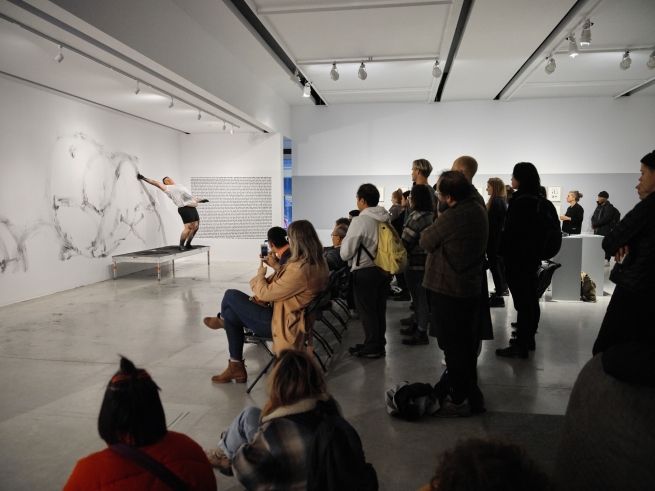
I keep thinking about Sheppard’s reading of a lacuna as a body of water filled with our attempts to analyze and understand our situations. It seems that that lake could embody both our straining to hear through crisis and our failed attempts. When one is faced with impossible circumstances, what can listening do?
Whistle Quartet (2001), an early score of Chacon’s, calls for four performers to play a score written for dog whistles, instruments whose frequencies are largely outside the range of human hearing. The piece, he writes in his notes, aims to replicate the way one might learn a song from an elder or leader, become part of a group, or lead a group when their predecessors are no longer there. In the piece, a player enters with and repeats a phrase—inaudible—and one by one, the others join in. The performance lasts all night.
The piece holds close that feeling of impossibility, but more than that, it focuses on the sense-making that can unfold across bodies or over time. In my imagination, it requires a focused, full-body kind of listening to perform, wherein the performers who enter last are forced to attend to their predecessors’ silences and to the hidden sounds they contain.
In the score, the line sketching out the whistle tones is doubled, then tripled, then quadrupled on the page. It calls to mind the image of that lake filled with fear and grief and dread and hope. How a score, a sound, or an action can attempt, impossibly, to stretch across that expanse, blowing ripples across its surface.
You can almost hear it.
Top Photo: Rights of Passage, a participatory performance by Lou Sheppard. Photo by Robin McCullough.
Photo of Raven Chacon at the Music Gallery in Toronto in 2019 taken by Terry Lim. Parallel 03 artwork courtesy of Raven Chacon.
Photo of performance documentation of Lou Sheppard's Colour Guard, Atlantic Flyway courtesy of Lou Sheppard. Photo of performance documentation of Sheppard's A Strong Desire taken by Rachel Topham Photography.
